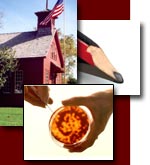| Site Map | Contacts | Links | Newsletter | |
Homeschool:
Biology
Definition
Biology the study of life, from the Greek bio meaning "life," and ology meaning "study of."
The Six Kingdom Classification System
- Archaea- one cell organism feeding on inorganic (non-living) matter, found near deep ocean thermal vents, and in hot springs.
- Monera- one cell organism with no nucleus (prokaryotic cell), bacteria.
- Protista- one cell organism with a nucleus (eukaryotic cell), protozoa.
- Plants- multicellular organism that use chlorophyll to make their own
food, and lack locomotion. There are two main types of plants.
- Simple
- Algae
- Mosses
- Vascular
- Ferns
- Non-flowering
- Flowering plants
- Simple
- Fungi- multicellular organism lacking locomotion that obtains food by
absorbing dead or living organisms. There are two types of fungi.
- Fungi
- Yeasts
- Molds
- Mushrooms
- Lichens
- Fungi
- Animals- multicellular organisms with locomotion obtaining food from
outside organic sources. There are two main types of animals.
- Invertebrates-(no backbone)
- Coelenterates- (hollow insides) sponges, jellyfish, and coral.
- Echinoderms- (spiny skin) starfish, and sand dollar.
- Mollusks- (soft body with hard shell) snails (one shell), clams (two shells), and ones with no shells.
- Arthropods- (jointed legs).
- Myriapods- Centipedes (40 legs) and Millipedes (100 legs).
- Crustaceans- Crabs, shrimp, crayfish, and lobsters.
- Arachids- (8 legs, 2 body parts) spiders, ticks
- Insects- (6 legs, 3 body parts) flies, grasshoppers, bees, etc.
- Vertebrates- (having backbones)
- Fish
- Amphibians
- Reptiles-cold blooded, lay eggs.
- Birds-warm blooded, lay eggs.
- Mammals-warm blooded, live birth.
- Invertebrates-(no backbone)
The Human Body—Nine Systems
- Circulatory System- heart, arteries, capillaries, and veins. Lymph nodes and the spleen help fight disease.
- Digestive System- mouth, esophagus, stomach, small intestines, large intestines (colon), and liver which produces bile which is stored in the gallbladder.
- Respiratory System- lungs, trachea, and bronchi
- Excretory System- kidneys, and bladder.
- Nervous System- Brain, and nerves.
- Endocrine System- glands that secrete hormones that regulate the body
activities.
- Pituitary - the master control gland, stimulates other glands, also growth hormone.
- Thyroid - secretes thyroxin which controls the body's metabolic rate.
- Parathyroids - controls calcium and phosphorus in the blood.
- Adrenal - adrenaline caused rapid increase in heart rate and blood pressure for fight or flight.
- Pancreas - produces insulin and glycogen.
- Sex glands - male hormone testosterone, female hormone estrogen.
- Skeletal System- bones
- Muscular System- muscles
- Reproductive System- male, female.
Links
- Online Biology Book: This is a great resource!
